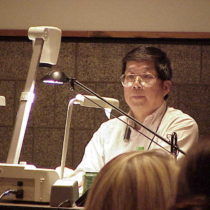Landscape Architecture for Landscape Architects › Forums › GENERAL DISCUSSION › Drawing with a good attitude
- This topic has 0 replies, 1 voice, and was last updated 14 years, 1 month ago by
 Mike Lin.
Mike Lin.
-
AuthorPosts
-
November 11, 2011 at 7:40 pm #159373
 Mike LinParticipant
Mike LinParticipant

Drawing with a Good Attitude
Many people feel they are unable to draw or sketch well either due to the lack of talented background or missing proper guided graphic skill. I have spent over 35 years of my life teaching people how to draw well with confidence, often I have seen people walked in with scary face, bad skill and have no talented background, but after spent a few hours or days in my workshop, not only can they draw well, but with ease and improved confidence. These experiences have given me the pleasure to share some of my thoughts with you as follows. It is so comforting to say that finally I have found a very easy way to tell people how to draw well with good quality and self confidence; that is “with well taught graphic skill” and “with good attitude”. Without both, most people will fail in trying to draw well.
The majority of people can not draw comfortably for the follow reasons:
- Want a perfect drawing: Remember that life is never perfect, and so how can you expect a drawing to be perfect? There is a big different between an artist and a designer. A drawing to an artist is a product like a painting, but to a designer, it is only a process like a schematic sketch. Therefore, you don’t need to be very skillful nor a master to draw well as long as you can graphically communicate your idea well with your clients. For example, if you can not draw an oak tree well, you can sketch it the best of your ability and even spell it in word and pointed into the oak tree so you took only the least amount of time and clients understood it immediately. It is perfectly alright not to be able to draw well as long as the clients can understand what you are trying to convey.
- Like to compete or compare: Most of us have grown up in a very competitive society, therefore we tend to like to compete and compare who is better in every thing or like a drawing, and this can only create more stress and worry. To draw well, one must not have this attitude and be prepared to be the worst within the group. With this great attitude in mind, you will earn more friends and draw without unnecessary pressure.
- Fear of failing: You never fail until you stop trying. Learn from your mistakes, and mistakes are the best experience you can have. Do not allow yourself to become discouraged. How can you succeed in drawing without failing a few drawings? As we know that every mistake made is a good experience for you as long as you are not to repeat it again, so if you are afraid of making mistakes, how can you be able to draw well? So don’t be afraid of trying to experiencing some challenges (mistakes) and making sure you do not repeat the same mistake twice. Keep in mind that don’t let anyone tell you that you cannot draw, because you can! You are the only one who can stop yourself from drawing well.
- Don’t like to be criticized: If your drawing is bad, the only way to learn is to know the true comment from someone knowledgeable in the field and if you are one like to be flattered, it can only delay your learning experience. I often tell my graphic participants that I sincerely like them personally but I simply just hate their drawing, so let us spend time to fix them with proper way and do not feel bad when the drawing is being criticized. Although sometime, if someone laughs at your drawings, this may be because they are jealous on what you can draw, just say: May I see yours or can you show me how to do it, this will get them off your back.
- Lack of self confidence: Good self confidence comes from a good successful experience, a good experience comes from improvement, a good improvement comes from mistakes made, and a mistake comes from “doing it”. Without trying to draw, how can anyone achieve self confidence in drawing? Therefore, don’t be afraid to just try to draw, this will contribute mistakes naturally, and then you need to ask for assistance so drawing can be criticized so same mistakes will not be repeated. Once you have achieved the confidence in drawing, you will likely want to draw more and more.
- Worry GPA or Promotion: Students are so worry about the grade point average that they spend a lot of time trying hard to achieve a good GPA, but when they are ready to leave school and prepare themselves for the job search; most employers require only good references, great portfolio with good drawing product and bubbly attitude. GPA is never required to be seen or discussed during the job hunting process. Same situation applies to the working designers; many of them worry about their job security and trying very hard to draw perfect so they can receive good promotion or award. I personally believe a good and skillful individual who will not worry about the promotion; it is his employer who is worry about possibly losing him to other firm. So I suggest not getting stress on GPA in school or promotion in the working place, then you will have a better attitude to draw more comfortably and easily.
- Miss guided graphic tricks: I have found most people can not draw not only because they have poor attitudes mentioned above, but were poorly taught in graphic tricks so drawing can not be improved more effectively. Many criticize by using sentences do not make sense, such as: You need to watch line weight (how do you watch it?), color does not work well (how does it work?), color needs a punch (do you punch it with grove?) or Keep on trying (trying same mistakes over and over?). Now you know that graphic tricks need to be very direct and to the point, I have listed 50 graphic tricks in my published book “Drawing and Designing with Confidence” that once you have mastered them with good attitude, drawing will improve drastically.
Having a good attitude means sharing with others, taking initiative, taking risks, being energetic, believing in and liking yourself, and listening to those older and more experienced than you. Having a good attitude will help you to loosen up and go for it, instead of being tight and afraid to try. Therefore when you draw, go ahead and take risks. Don’t be afraid to make mistakes. If you make a mistake, just say “I like it”, or say “I am not done yet” and turn it into something positive. A great artist can turn any mistake into part of the drawing. Always have confidence in your work and take criticism with a good sense of humor. Know that criticism could only lead to better ideas. Loose people don’t worry about what others think about their drawing, but they do listen to others to pick up ideas that are informative.
I like to suggest the following ways to improve the drawing skill:
- Watch other people draw so you are familiar with the drawing process.
- Collect graphic reference books so you can use them as examples
- Learn to copy or imitate other people’s drawings
- Practice constantly to get loose and achieve confidence
- Search for honest criticism that will lead you into less repeated mistakes
- Create opportunity so you have incentive to draw.
- Share what you know with others, this can only educate yourself twice
The following before/after drawings are from two participants who do not have any artistic or talented background nor with proper drawing attitude when they did the “before” drawings. After graphic tricks were taught and practiced with good attitude introduced, the “after” drawings were drawn in three hours and one week respectively. So get excited and go for it, with good attitudes and proper graphic skill, anyone can draw well with great confidence.

Before/After drawings after three hours of instruction

Before/After drawings after one week of instruction
-
AuthorPosts
- You must be logged in to reply to this topic.


